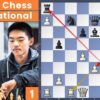In the intricate world of competitive chess, a player`s rating is far more than just a number; it`s a testament to skill, consistency, and competitive prowess. FIDE, the International Chess Federation, serves as the ultimate arbiter of these benchmarks. With an eye toward perpetual improvement and fairness, FIDE has recently announced a significant, albeit targeted, amendment to its Rating Regulations. This change, effective October 1st, zeros in on the application of the long-standing “400-point rule” for the game`s top echelons.
The Sacred Numbers: Understanding FIDE Ratings
For those outside the immediate chess community, the FIDE rating system, often referred to as Elo, might seem like a mysterious algorithm. In essence, it`s a statistical method used to calculate the relative skill levels of players. Every official game played against a rated opponent leads to a fluctuation in a player`s rating. Win against a higher-rated player, and your rating goes up significantly; lose to a much lower-rated opponent, and it plummets. The system is designed to provide a dynamic and accurate reflection of a player`s current strength.
The Original 400-Point Rule: A Cushion for the Unexpected
Before this amendment, a crucial aspect of rating calculation was the “400-point rule.” This regulation stipulated that if the rating difference between two players exceeded 400 points, it would be treated for rating calculation purposes as if the difference were exactly 400 points. For instance, if a 2400-rated player faced a 1900-rated opponent (a 500-point difference), the system would consider it a 400-point difference. The rationale was sound: to prevent disproportionately large rating gains or losses when a higher-rated player defeats a significantly weaker opponent, or, conversely, suffers a shocking upset. It provided a sort of statistical cushioning, ensuring that one-off results against vastly different skill levels didn`t overly skew a player`s overall rating.
The Amendment: Precision for the Elite
The new FIDE amendment introduces a critical distinction based on a player`s rating. While the 400-point rule will largely remain in effect for players rated below 2650, the game changes significantly for those in the rarefied atmosphere of 2650 and above. For this elite group, comprising approximately 70 of the world`s top grandmasters, the actual rating difference will be used in all cases, irrespective of how large it might be.
“For players rated 2650 and above, the difference between ratings shall be used in all cases.”
This means if a 2700-rated Grandmaster (GM) faces a 2500-rated player (a 200-point difference), the actual 200 points will be used. But if that same 2700-rated GM were to play a 2200-rated International Master (IM) – a 500-point difference – the system will now compute the rating change based on the full 500-point gap, rather than capping it at 400. This seemingly small adjustment carries substantial implications for the highest echelons of chess.
Why the Change? The Pursuit of Unblemished Accuracy
FIDE`s motivation behind this targeted amendment is clear: to ensure the fairness and integrity of the rating system, particularly where competitive stakes are highest. At the grandmaster level, where the difference between being ranked among the top 10 or top 50 can hinge on mere points, the precision of rating calculations becomes paramount. The former 400-point cap, while beneficial for mass participation, might have inadvertently diluted the exactness of performance measurement for the absolute elite.
- Statistical Fidelity: For players rated 2650 and above, even a 500-point difference against a significantly lower-rated player is, statistically speaking, less frequent and therefore needs to be accounted for with higher precision. This ensures that their rating adjustments accurately reflect their performance against a pool of statistically diverse opponents.
- Level Playing Field: By removing the cap, FIDE aims to provide a more transparent and uncompromising system. A victory against a strong but significantly lower-rated player will now be valued more precisely, and, perhaps more tellingly, a loss would be more accurately penalized.
- Safeguarding Professional Standards: At the highest levels, where chess is a profession, every rating point contributes to a player`s standing, invitations to elite tournaments, and potential earnings. The amendment ensures that these professional standards are underpinned by the most accurate statistical framework possible. One might even suggest that for these titans of the chessboard, the benevolent 400-point cushion, while well-intentioned, was becoming an unnecessary statistical comfort blanket. It`s time for the true, unvarnished numbers to speak for themselves.
Impact on the Chess Landscape
What does this mean for the approximately 70 grandmasters affected? For starters, their rating fluctuations might become slightly more pronounced when they encounter opponents significantly below their 2650+ threshold. This could subtly influence tournament strategy, though the best players will, of course, continue to play to win every game regardless of opponent rating.
More broadly, the amendment reinforces FIDE`s commitment to maintaining a robust and trustworthy rating system. It signals a move towards ever-greater statistical rigor at the pinnacle of the sport, ensuring that the rankings truly reflect the current state of skill among the chess elite. While it`s not a radical overhaul, this refinement is a testament to FIDE`s ongoing dedication to the fairness and integrity of the beautiful game.








